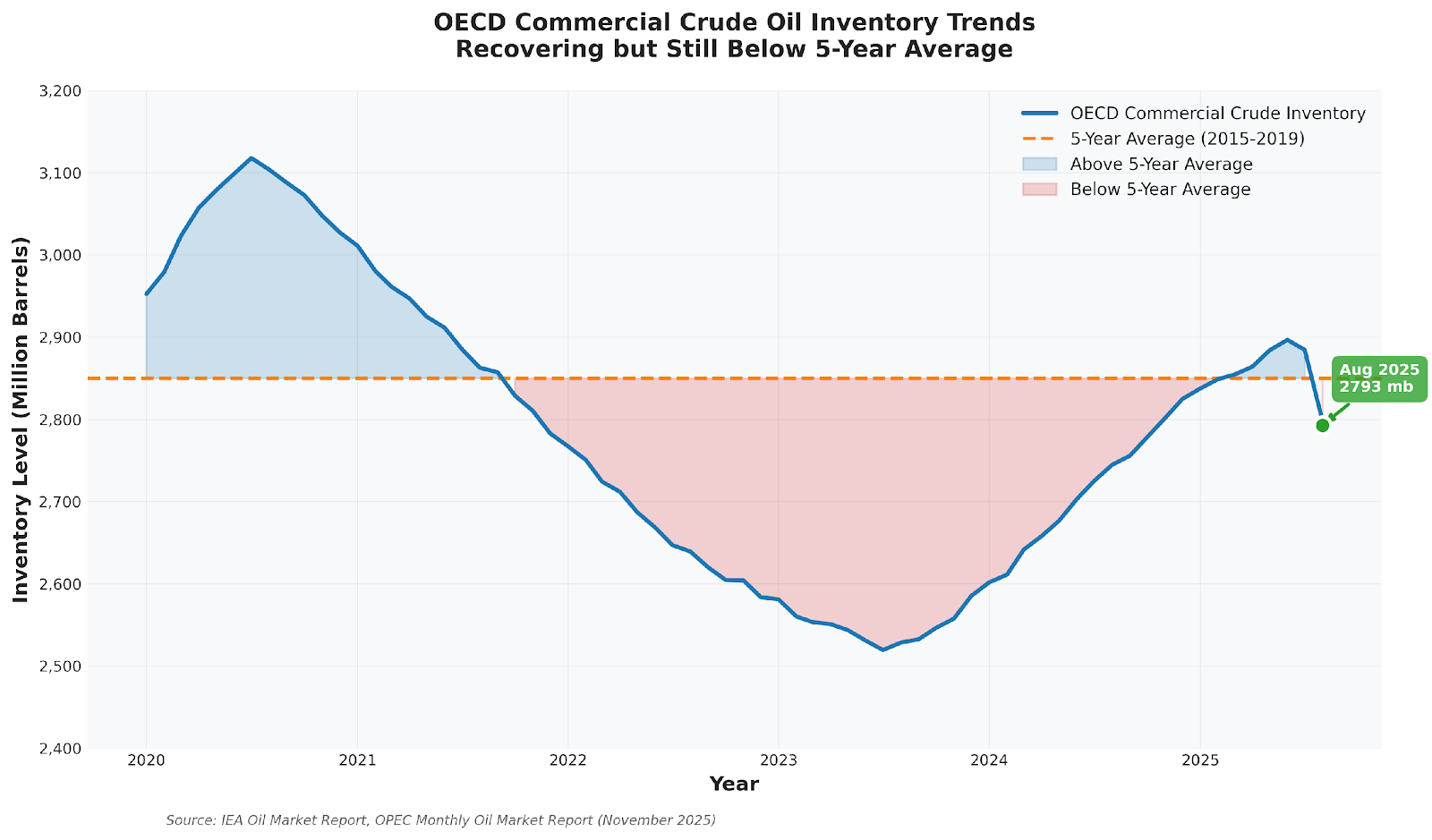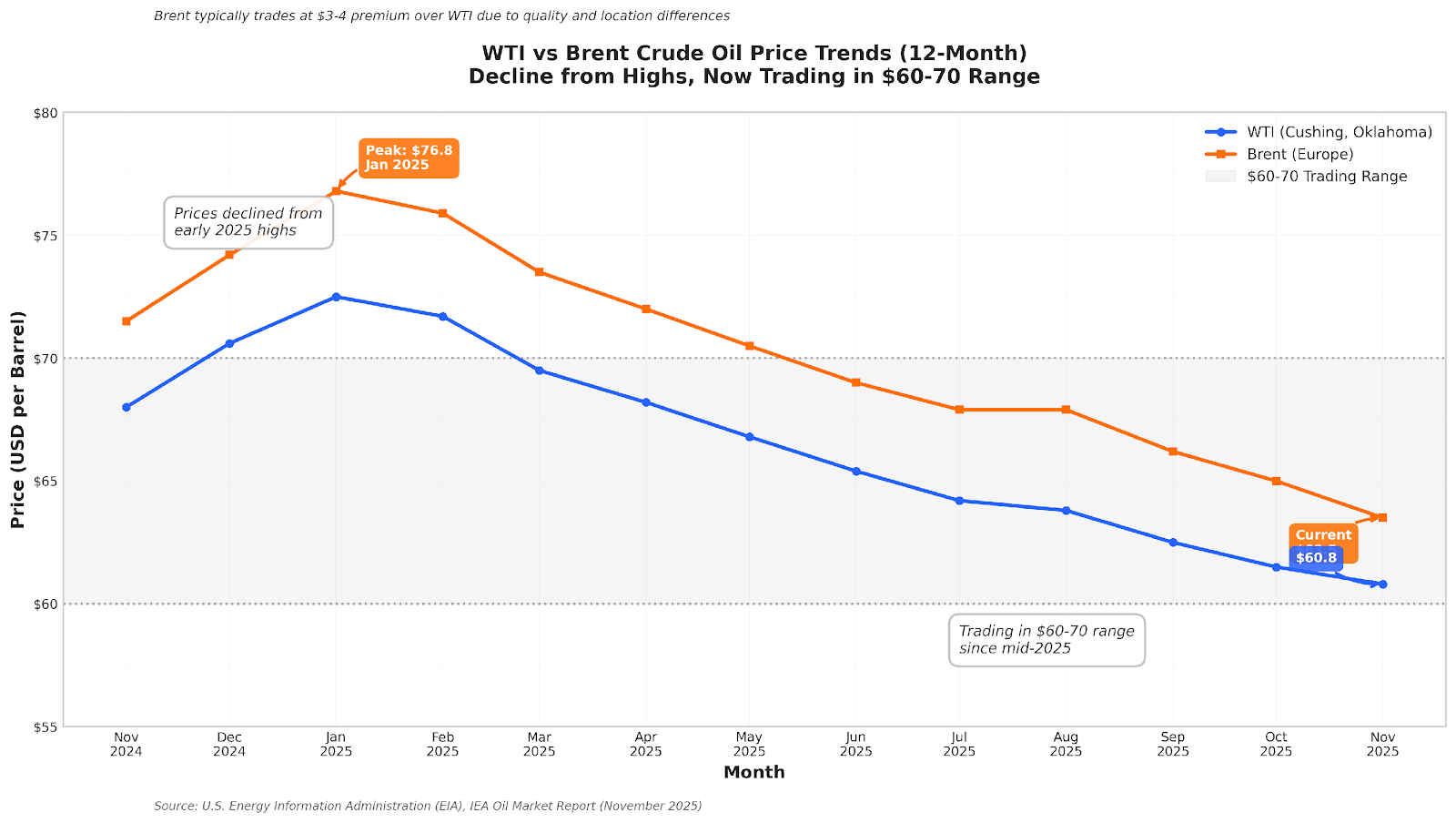市场资讯及洞察
.jpg)
摘要
IEA 最新月报显示,全球石油需求增速放缓但仍具韧性。尽管库存持续回升,但 OECD 库存整体仍低于五年均值,市场对供应中断高度敏感。OPEC、IEA、EIA 均上调非 OPEC 供应,未来可能出现“松中带紧”的供需结构。原油价格在供应宽松预期与地缘扰动之间反复震荡,波动率下降但敏感度上升。油市表现也可能通过风险偏好外溢至能源板块、商品货币及相关市场。
一、全球原油供需前景:IEA 月报核心要点
国际能源署(IEA)最新原油月报显示,全球石油需求虽较去年降温,但整体依旧保持韧性 [1]。先进经济体消费表现好于预期,有效抵消部分新兴市场的疲弱需求。IEA 预计 2025–2026 年全球石油需求将保持温和增长。然而在供应方面,如果 OPEC+ 维持当前产量政策且需求不出现明显下滑,全球石油市场未来数个季度可能重新进入“边际紧平衡”状态。IEA 同时指出,高油价、全球经济放缓、电动车渗透等因素正在逐步压制需求增速,使油市呈现出“短期紧平衡、长期温和宽松”的结构。
二、多机构观点对比:OPEC、EIA 与 OECD 数据
三大机构对于未来市场平衡的看法存在显著差异,这主要源于对非 OPEC+ 供应增长和需求韧性的不同假设。总体来看,市场普遍认同未来供应将更加充裕,但对于过剩的规模和时间点存在分歧。

图 3:三大机构对 2025-2026 年需求与供应增长的预测对比,显示供应增长普遍超过需求增长,预示市场将进入供应过剩周期。
OPEC 的观点相对乐观。OPEC 预计 2025 年全球石油需求将增长约 130 万桶/日,2026 年略高至 140 万桶/日 [2]。与此同时,OPEC 在最新报告中连续上调非 OPEC 供给预期,并首次将 2026 年市场从“短缺”调整为“小幅过剩”,反映其判断未来供应增长可能快于需求。
EIA 的判断更偏向供应充裕。EIA 上调了美国页岩油产量预测,指出 2025 年美国原油产量将创历史新高。同时,全球供应预期被上调至日均 1.06 亿桶,高于全球消费的 1.041 亿桶,意味着未来库存可能持续累积 [3]。EIA 预期 2025–2026 年库存增加将对油价形成中期压力。
OECD 库存虽然持续回升,但仍低于五年均值。IEA 数据显示,今年全球观测库存前八个月净增约 2 亿桶,但 OECD 商业库存仍比五年均值低约 6700 万桶。整体来看,库存虽然恢复,但仍处历史偏低区间,使油市对供应中断的敏感度依旧很高。

图 1:OECD 商业原油库存近 5 年对比最新水平,显示库存虽有回升但仍低于五年均值。
三、原油价格走势:WTI 与 Brent 如何消化预期
2023 年下半年,布伦特因供应紧张和地缘冲突预期一度突破每桶 90 美元。然而进入 2024–2025 年,随着供应回升和库存恢复,油价整体震荡下移。近期价格承压主要来自供应过剩预期强化以及美国库存意外上升。

图 2:WTI 与 Brent 价格从 2025 年初的高位回落,近期在 60–70 美元区间震荡。
尽管地缘事件偶尔推升价格,但反弹难以持续,因为供应宽松的结构性预期迅速重新主导市场。WTI 与 Brent 的期限结构一度出现小幅 Contango,显示短期供应充裕压制近端价格,而远月因长期需求预期而保持相对坚挺。整体来看,油市呈现低波动、弱趋势但对消息高度敏感的特征。
四、驱动油市的关键变量:地缘政治与供应端不确定性
运输通道风险仍是油市最大的潜在冲击点之一。全球三分之一海运原油经过霍尔木兹海峡,一旦受阻便可能引发油价剧烈波动。衍生品定价显示断供概率虽低,但属于典型的“低概率、高冲击”事件。
OPEC+ 的政策滞后性也带来结构性波动。减产会压低库存、推高价格,但高油价又刺激非 OPEC 增产,使市场重新宽松。美国页岩油增速放缓进一步加剧供应端的不确定性,削弱其作为“摇摆产能”的角色。此外,俄罗斯、伊朗等国因制裁和冲突导致出口波动,更加剧油市敏感性。
五、油市变化的外溢影响
能源板块通常与油价同方向变动,但反应速度较油价更平缓。油价对风险偏好的溢出效应也容易影响澳元等商品货币。大宗商品价格上行往往提升商品出口国的贸易条件与风险情绪,而价格下跌则可能压制相关货币表现。
六、原油市场风险提示
- 数据发布风险: EIA 每周库存、IEA 与 OPEC 月报可能导致短线波动。
- 地缘政治风险: 产油区冲突、海运通道中断、制裁变化均可能影响供需平衡。
- 宏观风险: 利率政策、美元走势及全球经济增速变化都可能改变需求前景。
结语
IEA 最新展望显示,全球油市进入“边际紧平衡”阶段:库存修复但仍偏低,供应端不确定性大于需求端。在这种结构性环境下,油市会对政策、地缘事件与供给变化表现出高度敏感。理解供需框架、关注库存趋势与识别关键风险,将是未来判断油市走向的关键。
参考资料
[1] IEA (International Energy Agency). (2025, October). Oil Market Report - October 2025. https://www.iea.org/reports/oil-market-report-october-2025
[2] OPEC (Organization of the Petroleum Exporting Countries). (2025, November). Monthly Oil Market Report. https://publications.opec.org/momr
[3] EIA (U.S. Energy Information Administration). (2025, November). Short-Term Energy Outlook. https://www.eia.gov/outlooks/steo/


The USDCHF has just reached a significant support zone providing a potential entry for a low-risk high return trade. In recent weeks the USD has an aggressive pulled back on the back of weaker then expected inflation figures. This has benefited the CHF and most other non-USD currencies as expectations of a potential pivot grow and money moves away from the Greenback.
From a technical perspective the price of the USDCHF has fallen to its lowest price since August 2022. The price has also largely been in a ranging pattern since 2010 between 1.03436 0.8741. In addition, besides the Covid years, the price has been in a tighter range between 0.94 and 1.03.
The current price zone has been a really important area of support and in the most recent test of this area, in August the price bounced quite strongly. Interestingly, during times of higher market volatility the price extends its lower bound of the range from 0.94 to 0.87. For example, the prices extended its range during the GFC and the Covid pandemic.
However, generally, the pair trades in the tighter range. Therefore, as it is arguable if the current market conditions represent volatility as sinister as the GFC or the Pandemic this current price action lends itself to a potential bounce over a further sell off. The bounce is also supported by the RSI which is not just oversold but showing the potential for a divergence.
With the price at an ideal entry point, it allows for a high potential risk reward trade. The trade’s target is 1.0075 as seen on the price chart.


热门话题
相信大家都有过和客服斗智斗勇的经历。那么以前是和人斗智斗勇,现在变成了和机器,情况如何呢?

前段时间发生一件很“有趣”的事情,就是我在邮局寄了一个包裹,但是很久过去了,网络上还是查不到有用信息,只是现实在某天寄出,就没有了下文。那么针对这个情况,我比较担心包裹是否有丢失的情况,但是有没有时间亲自跑去邮局一趟,于是我就打电话给邮局,想找个人工客服来问问情况。但是当我打电话过去的时候让我大受震撼,对面的客服是一个纯AI的客服,也就是人工智能客服,于是本着好奇的原则,就和AI交流了下,看看能不能帮我解决问题,但是在一番对话后我发现,绕了半天,对方只会做一些重复性并且机械的回答,于是在焦急战胜了兴趣后,我还是选择和AI客服书说,我想找个活人聊聊。之后就转人工客服了。然而这个事还没完,转人工客服让我等待了接近半个小时,才说上话,然后进行交涉后,才解决了问题。

和周围人吐槽这个事情后才发现,并不只是我一个人遇到AI客服的时候感觉到有些浪费时间,而且这个问题,也已经存在了好几年了。其实非人工客服已经存在很久了,但是真正开始大量实行是在2018年前后。在那个时期开始,大数据分析,Al算法,也是芯片正式进入7nm工艺的时间点。突如起来的科技进步,大量的新型技术氤氲而生。从那时起,AI客服开始大量进入人们的视野。不仅仅是我,应该有不少人都遭受过人工智能客服的摧残。通常来说,我们打电话找客服的目的有两个,第一个就是查询问题,第二个就是解决问题。对于第一个来说,查询问题,AI客服可以很好的帮助到消费者,很大程度上也可以提升效率节约时间,减少成本。但是对于第二个问题,AI客服在目前就很难帮助到大家,反而容易像打太极一样来回绕,有时候不能理解客户问题,有时候本身算法也不支持其帮忙解决这个问题。因此,在现阶段来说,人工客服还是在一定程度上优于AI客服的。但是为什么现在很多公司都在大力使用AI客服呢?其原因有如下几个:第一就是削减成本。培养一个客服,或者是一个客服团队,将会耗费巨大的人力,金钱,时间。在这种情况下,公司的客户服务部门也是最难看到效益的部门,虽然其是必不可少的。在前些年,很多公司未了削减成本,就使用了外包客服团队,虽然减少了成本,但是也造成后很多不好的后果。所以在AI客服出现之后,很多公司就发现,AI客服,可以很大程度上削减成本,更重要的是,可以轻易的做到24小时为客户服务。

第二个原因就是,现在的很多客服越来越模式化。首先礼貌问答,遇到问题,帮您反馈。最后解决方法,给您一个折扣。这样的流程化,逐渐的使得客服逐渐变化为:人工-人工流程-人工智能。因此,不少公司就想到,既然都是流程化的解决问题,那么为什么需要高成本的聘用活人呢?但是,对于消费者来说,AI客服并不一定是个很好的选择。2022年,TechSee一项调查的受访者表示,“43%的人因为糟糕的客户服务而更换产品或取消合同。” 这比 2019 年高出 4%。考虑到人们对聊天机器人的复杂体验,赌注太高了。如果不想和AI客服交流,那就需要花费大量时间进行等待,这也变相增加了客户的时间成本。因此,在进行简单服务的时候,AI客服的确可以增加效率。但是复杂性问题,或者是需要沟通才能解决的问题上,还是人工更胜一筹。

人工智能客服的初衷是增加效率,提高客户满意度的,但是滥用AI客服却会使得客户体验下降,反向提升满意度。综合来说,目前AI客服并不能完全代替人工,希望AI客服可以更进一步,在人工和AI的结合下,可以让客户体验加强的同时,还可以节约成本。免责声明:GO Markets分析师或外部发言人提供的信息基于其独立分析或个人经验。所表达的观点或交易风格仅代表其个人;并不代表GO Markets的观点或立场。联系方式:墨尔本 03 8658 0603悉尼 02 9188 0418中国地区(中文) 400 120 8537中国地区(英文) +248 4 671 903作者:Neo Yuan | GO Markets 助理分析师


Shares of Deere rise as financial results exceed expectations Deere & Company (NYSE: DE) announced financial results on Wednesday for the fourth quarter that ended on October 30, 2022. The US manufacturer of farm machinery and industrial equipment reported revenue of $15.536 billion for the quarter, which was above analyst forecast of $13.443 billion. Earnings per share reported at $7.44 per share vs. $7.112 per share expected. ''Deere’s strong performance for both the fourth quarter and full year is a tribute to our dedicated team of employees, dealers, and suppliers throughout the world,'' John C.
May, CEO of the company said in a statement. ''We’re proud of their extraordinary efforts to overcome supply-chain constraints, increase factory production, and deliver products to our customers,'' he added. The stock was up by around 5% on Wednesday, trading at $441.33. Stock performance 1 month: +12.79% 3 month: +69% Year-to-date: +67% 1 year: +94% Deere & Company price targets Deutsche Bank: $374 Goldman Sachs: $420 Argus Research: $420 Citigroup: $425 Morgan Stanley: $424 Credit Suisse: $447 Wells Fargo: $423 Oppenheimer: $365 Jefferies: $400 JP Morgan: $325 Deere & Company is the 84 th largest company in the world with a market cap of $132.90 billion.
You can trade Deere & Company (NYSE: DE) and many other stocks from the NYSE, NASDAQ, HKEX, ASX, LSE and DE with GO Markets as a Share CFD. Sources: Deere & Company, TradingView, MarketWatch, MetaTrader 5, Benzinga, CompaniesMarketCap


Medtronic posts mixed results Medtronic Plc (NYSE: MDT) reported latest financial results for its second quarter of fiscal year 2023, which ended October 28, 2022 on Tuesday. The medical technology company posted mixed results for the quarter. Revenue reported at $7.585 billion (down 3% year-over-year) vs. $7.698 billion expected.
Earnings per share reported at $1.30 per share (down by 2% year-over-year) vs. $1.277 per share estimate. "Slower than predicted procedure and supply recovery drove revenue below our expectations this quarter. We continue to take decisive actions to improve the overall performance of the company, including streamlining our organizational structure, strengthening our supply chain, driving a performance culture, and strategically allocating capital to support our best growth opportunities with the investments they deserve," Geoff Martha, CEO of the company said in press release. "We're seeing the benefit of these changes – along with new incentives and strong execution – in certain businesses, and we're focused on ensuring these efforts translate into improved performance across the company. Looking ahead, we're confident we have a clear path to delivering durable growth and increased shareholder value," Martha concluded.
The stock was down by around 5% on Tuesday at $77.74 a share. Stock performance 1 month: -2.62% 3 month: -8.79% Year-to-date: -20.45% 1 year: -27.42% Medtronic price targets Barclays: $90 Truist Securities: $89 Mizuho: $100 Jefferies: $87 Morgan Stanley: $97 RBC Capital: $110 Wells Fargo: $96 Stifel: $105 Medtronic is the 114 th largest company in the world with a market cap of $109.37 billion. You can trade Medtronic Plc (NYSE: MDT) and many other stocks from the NYSE, NASDAQ, HKEX, ASX, LSE and DE with GO Markets as a Share CFD.
Sources: Medtronic Plc, TradingView, MarketWatch, MetaTrader 5, Benzinga, CompaniesMarketCap


The market in recent months has created exceptionally difficult conditions to trade. Low volatility and obscure price action has reduced the volatility available for traders to capitalise on. These conditions have affected FOREX, Equity, and Index trading.
It has been specifically difficult for momentum and trend following traders as a certain level of volatility is needed for trader to return profitable trades. How to spot low volatility The Average True range or ATR range can be an important indicator in determining the level of volatility in a market or asset. It measures the average trading range of a particular asset’s price over a period.
It can exceptionally be helpful in determining how volatile the asset is at a certain point in time, or how volatile an asset is compared to another one. For instance, looking at the ATR for the Dow Jones, it has been getting progressively lower and is at its lowest level since August indicating a reduction in volatility. The Market Volatility Index or the VIX measures volatility across the S&P 500 is also an important indicator to not just gauge market volatility, but also general market sentiment and emotion.
When fear and greed are prominent in the market volatility tends to increase and when they dissipate, they tend to decrease. As the chart shows, volatility has been reducing to levels not seen since the rally in August 2022. The characteristics of the chart are also interesting as the VIX acts much more in waves then other indices do.
How can you optimise your trading during periods of low volatility? Tips for trading in low volatility markets Understand that breakouts will fail. Specifically for traders who like to use strategies based on momentum breakouts, during times of low volatility the price means to stay close to moving averages and mean price points both on an intra and inter day level.
Wait for confirmation before a momentum move. Although breakouts are less common in low volatility markets, they do still occur. In this instance, it is ideal to wait for a confirmation or retest of an important level before entering trades.
Confirmation can be supported by strong candle in support or increased volume. Being patient is essentially in times of low volatility. Opportunities that may have otherwise eventuated.
Utilising volume and strong candlesticks as secondary Price tends to stay close its mean. This means that if a price does break out or break down, the price often swings back to the mean. The mean may be a simple moving average, Volume Weighted Average, or some other measure.
In essence it does not really matter what is used, rather than the price tends to retrace back to the mean in some manner. Therefore, these conditions lend themselves to mean reversion systems or strategies. As seen on the chart below, the price has reverted to the 20-period moving average on multiple occasions.
Using multiple time frame analysis for identifying support and resistance. As previously stated, when there is low volatility, finding real breakouts that will last becomes more difficult. By ensuring that the breakouts or breakdowns in price are occurring across multiple timeframes a trader can enhance their chance of it being sustained as their will likely be a higher level being traded at longer term levels.
Trading can be difficult during periods of low volatility. However, this does not mean traders should not trade. Rather, traders should be aware of potential obstacles and difficulties that may arise and the strategies that can help work though these difficulties.


As the week comes to an end, many cryptocurrency investors grow increasingly nervous. This emotional sentiment has resulted in bitcoin’s new 18 month’s low price, since December 2020. It has also caused a well known crypto company, Celsius, to suspend client’s withdrawals.
Bitcoin started the week at $27,000 USD which was a 10% decrease from Friday’s closing price of around $30,000 USD. Since the opening of the week, it has dropped another 23% to almost $20,000 USD. This is almost a 70% decline from last October’s peak of nearly $69,000 USD.
This sharp decline also mirrored the bearish sentiment across other risk assets. US equities closed 2.9% lower on Friday and continued to decrease as the week proceeded. The 2% decline of the US equity futures would have also been an indicator of how the US equities markets would be performing.
The pressure on risk assets comes after US consumer prices soared 8.6 per cent in May from the same month a year earlier, more than economists anticipated and the highest reading since 1981. The increasing selling pressure across the cryptocurrencies scene prompted Celsius to put a halt on client’s withdrawals from their cryptocurrency accounts. This is not a good sign for the four-year-old start-up company.
Celsius offers an array of services, including their ‘Swap’ tool. This service allows users to exchange their cryptocurrencies for stablecoins that are linked to fiat currencies, such as the USD. The company’s reasoning for the halt was to “stabilise liquidity and operations while we take steps to preserve and protect assets”, and that it will look to resume activity as soon as possible.
Celsius’ decision has come at a bad time as weeks earlier, Terra, a popular stable coin linked to the US dollar, had collapsed alongside its sister token Luna. This collapse had wiped out tens of billions of dollars in market value for many investors. Overall, the cryptocurrency market is on a decline.
This is because the biggest coin, bitcoin, is currently trending downwards and this would also translate across all other alt-coins. Source: GO Markets MT5, Celsius, TradingView, Financial Times, AFR

